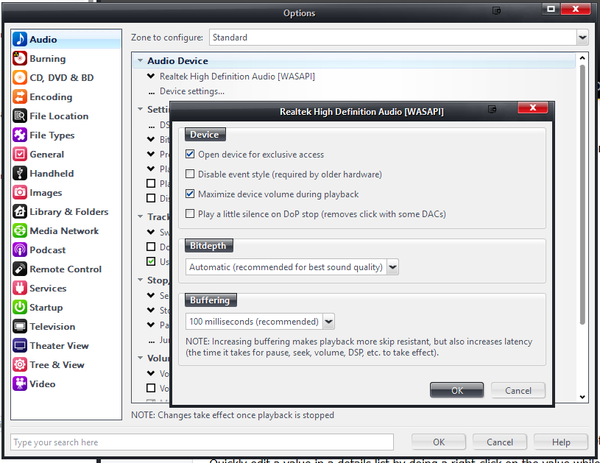Difference between revisions of "WASAPI"
From JRiverWiki
| Line 2: | Line 2: | ||
| relatedPage=[[Audio Setup]]}} | | relatedPage=[[Audio Setup]]}} | ||
| − | WASAPI is Microsoft's most modern method for talking with | + | The [http://msdn.microsoft.com/en-us/library/windows/desktop/dd371455%28v=vs.85%29.aspx Windows Audio Session API (WASAPI)] is Microsoft's most modern method for talking with audio devices. It is available in Windows Vista, Windows 7, and later versions of Windows. It allows delivering an unmodified bitstream to a sound device, and provides benefits similar to those provided by ASIO drivers. |
| − | WASAPI support was first added to Media Center 13. Media Center 15 added event style WASAPI support. | + | WASAPI support was first added to Media Center 13. Media Center 15 added event style WASAPI support, and MC 18 made this the default. |
| − | + | == WASAPI Options == | |
| − | + | You can access WASAPI options in Media Center via: | |
| − | + | <span style="color:#8B4513">Tools > Options > Audio > Audio Device > Device settings</span> | |
| − | + | [[File:MC19-Audio-WASAPI Device Settings.png|thumb|600px|none|Options available for WASAPI connected devices.]] | |
| − | + | From here you can: | |
| + | * Enable [[Exclusive access]] of the audio device. | ||
| + | * Disable [[WASAPI Event Style]] for supporting older hardware. | ||
| + | * Set Media Center to [[Maximize device volume|automatically maximize the audio device's system volume control]] during playback. | ||
| + | * Alter Buffering settings if needed to deal with troublesome hardware or drivers. | ||
| + | * Enable the Play a little silence option which can help prevent clicks and pops when starting and stopping playback that occurs on some audio devices | ||
| − | + | == More == | |
| − | + | * An [http://yabb.jriver.com/interact/index.php?topic=48478.0 Interact thread on the original creation of WASAPI] | |
| − | |||
| − | |||
| − | |||
| − | |||
| − | |||
| − | |||
| − | |||
| − | |||
| − | |||
| − | |||
| − | |||
| − | |||
| − | |||
| − | |||
| − | |||
| − | |||
| − | |||
[[Category: Frequently Asked Questions]] | [[Category: Frequently Asked Questions]] | ||
Revision as of 23:27, 16 April 2014
- See also: Error: Template must be given at least one article name
The Windows Audio Session API (WASAPI) is Microsoft's most modern method for talking with audio devices. It is available in Windows Vista, Windows 7, and later versions of Windows. It allows delivering an unmodified bitstream to a sound device, and provides benefits similar to those provided by ASIO drivers.
WASAPI support was first added to Media Center 13. Media Center 15 added event style WASAPI support, and MC 18 made this the default.
WASAPI Options
You can access WASAPI options in Media Center via: Tools > Options > Audio > Audio Device > Device settings
From here you can:
- Enable Exclusive access of the audio device.
- Disable WASAPI Event Style for supporting older hardware.
- Set Media Center to automatically maximize the audio device's system volume control during playback.
- Alter Buffering settings if needed to deal with troublesome hardware or drivers.
- Enable the Play a little silence option which can help prevent clicks and pops when starting and stopping playback that occurs on some audio devices
